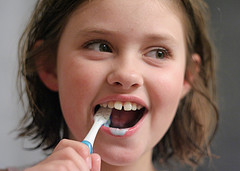What’s in children’s toothpaste?
A controversial topic: What about today’s children’s toothpastes? If you look at the shelf, it looks colorful and in all possible flavors….Nice marketing perhaps, but what about the consequences for your body?
Ingredients
That sugar is an enemy of healthy teeth is not news. The flavors in children’s toothpaste often contain sugar, so a warning for your children’s teeth.
Second, most brands contain the ingredient fluoride. Fluoride helps to prevent cavities and has been advised for this reason for decades. However, from the biological point of view, supported by various studies, a different insight is now appearing. Until the beginning of the 20th century, a water source containing fluoride was considered toxic and was therefore not used. Nowadays, there are several studies that show that fluoride helps against cavities, but at the same time it is toxic and affects the nervous system. Various studies have shown even more severe negative effects.
Hans Beekmans: ‘The Ivoren Kruis advises to use toothpaste with fluoride. It is striking that they mention that no side effects occur with the ‘recommended amounts’. The question I then ask is: how much toothpaste do you think your child swallows? Is this still within the ‘recommended amounts’?
Since I follow a biological line of thought, my preference is for a toothpaste without fluoride. Nowadays, the better drugstores often also offer a fluoride-free alternative, such as the toothpastes from Lavera or Weleda.
Prevention of caries or cavities
In the end, what matters is the prevention of dental caries. What are the alternatives to create strong dentin and prevent tooth decay?
Sufficient Calcium, Magnesium and Vitamin D3 are the most important substances. If you don’t want to give your child nutritional supplements, there are plenty of ‘common sense’ options.
Think of playing outside every day, because the current computer generation quickly spends too much time indoors. Under the influence of the ultraviolet radiation of sunlight on the skin, the body produces vitamin D3 itself, free of charge.
Some foods of which the body absorbs the calcium well are: dark green vegetables, for example broccoli and kale, but also nuts and seeds, dried figs or apricots. The advantage of these calcium-rich foods is that they also contain magnesium from nature, so that the calcium is well absorbed. This immediately makes the disadvantage of milk clear: the calcium from milk cannot be absorbed properly by the body because the magnesium content in milk is low. By the way, dried figs and/or apricots are a tasty ‘candy’, not only for children!
Credentials:

